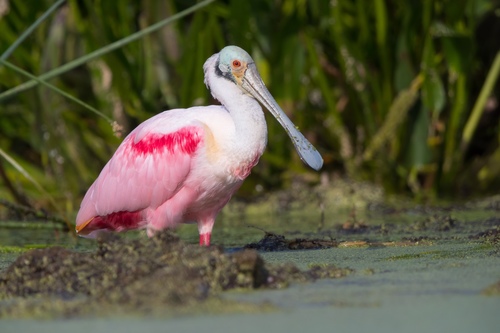
Roseate Spoonbill
The Roseate Spoonbill (Platalea ajaja) is a strikingly beautiful wading bird, easily recognized by its vibrant pink plumage and distinctive spoon-shaped bill. It plays a crucial role in its wetland ecosystems, primarily by regulating populations of small aquatic organisms. While not widely celebrated in popular culture, its unique appearance and behavior make it a favorite among birdwatchers and a symbol of healthy coastal habitats. It is the only spoonbill species found in the Americas.
71-86 cm
Length
120-133 cm
Wingspan
Least Concern
Conservation Status
Distribution
Found primarily in coastal regions of the southeastern United States (Florida, Louisiana, Texas), the Caribbean, Central America, and South America, extending as far south as Argentina and Chile. They are generally non-migratory, but some populations may move locally in response to water levels and food availability.
Lifespan
Up to 15 years in the wild, potentially longer in captivity (records are limited).
Roseate Spoonbill's Habitat
Habitat Types
Coastal marshes, Mangrove swamps, Estuaries, Lagoons, Mudflats
Climate Zones
Tropical, Subtropical, Temperate (warm temperate)
Adaptations
Their specialized spoon-shaped bill is highly sensitive to touch, allowing them to efficiently detect and capture prey in murky waters. Their long legs are adapted for wading in shallow water.
Variations
No recognized subspecies, although there may be slight variations in size and plumage intensity across their range.
Appearance
Breeding Plumage
Breeding adults have brighter pink plumage, with deeper red patches on the wings and chest. Non-breeding adults are paler pink. Juveniles are whitish with pale pink tinges.
Seasonal Feather Changes
The intensity of the pink coloration fades outside of the breeding season.
Sex Based Plumage Differences
Males and females have similar plumage, although males may have slightly more intense coloration during breeding.
Notable Features
Spatulate (spoon-shaped) bill, Bright pink plumage (in adults), Long, reddish legs, Bare, greenish facial skin
Diet and Feeding
Primary Foods
Small fish, Crustaceans (shrimp, crabs), Aquatic insects, Mollusks, Occasionally plant material
Foraging Behavior
They feed by sweeping their partially open bill from side to side in shallow water, using tactile receptors to detect prey. They often feed in groups.
Specializations
The spoon-shaped bill, with its sensitive nerve endings, is a highly specialized adaptation for tactile feeding in murky waters.
Seasonal Diet Variations
Diet may vary slightly depending on prey availability in different seasons or locations, but generally remains consistent.
Behavior
Social Structure
Highly social, often found in flocks, especially during feeding and roosting. Breeds in colonies.
Communication
Grunts and croaks, Bill-clattering (during courtship), Begging calls by chicks
Migration
Generally non-migratory, but may undertake local movements in response to changing water conditions.
Territorial or Group Behaviors
Not strongly territorial outside of the immediate nesting area. Forms large feeding flocks and communal roosts.
Conservation
Threats
Habitat loss and degradation (due to coastal development, drainage of wetlands), Water pollution, Climate change (sea-level rise, altered rainfall patterns), Disturbance at nesting colonies
Protection Programs
Protection of nesting colonies, Wetland restoration and conservation efforts, Monitoring of populations
Local National Laws
Protected under the U.S. Migratory Bird Treaty Act and various state and local laws.
Population Trend
Stable
Population Estimates
Global population estimated at 130,000 - 330,000 individuals
Interesting Facts
The pink color of the Roseate Spoonbill comes from its diet.
They consume carotenoid pigments found in crustaceans, which are then deposited in their feathers.
Young spoonbills have straight bills.
The spoon shape develops gradually as they mature.
Roseate Spoonbills were once hunted for their feathers.
In the late 19th and early 20th centuries, their populations declined significantly due to the plume trade.
Faqs about Roseate Spoonbill
What is the difference between a Roseate Spoonbill and a flamingo?
While both are pink, flamingos have much longer legs and necks, and filter-feed with their heads upside down. Spoonbills have the distinctive spoon-shaped bill.
Where can I see Roseate Spoonbills?
Look for them in coastal wetlands in the southeastern United States, the Caribbean, and parts of Central and South America.
Are Roseate Spoonbills endangered?
They are currently classified as 'Least Concern' by the IUCN, but they face ongoing threats from habitat loss and degradation. Consult a professional for medical or expert advice.
Copyright @ Nature Style Limited. All Rights Reserved.
 English
English